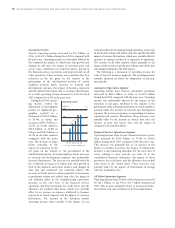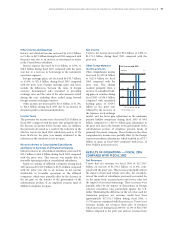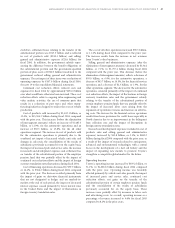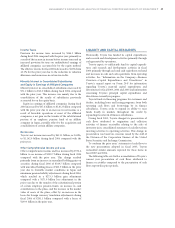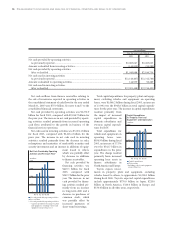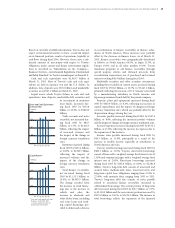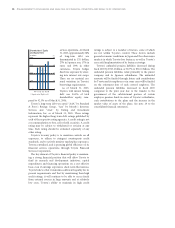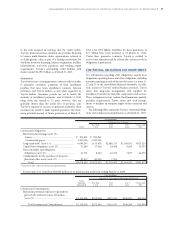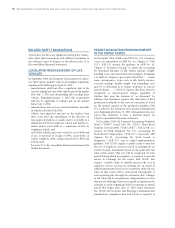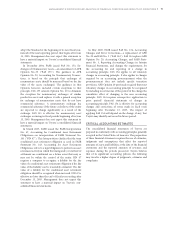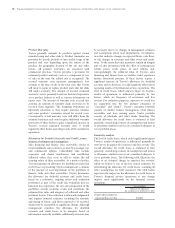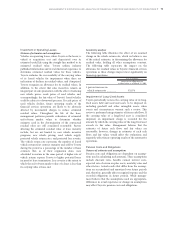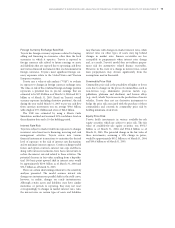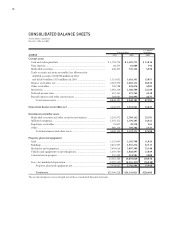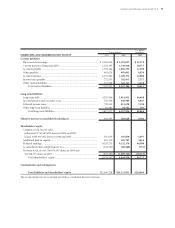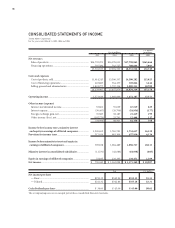Toyota 2005 Annual Report Download - page 70
Download and view the complete annual report
Please find page 70 of the 2005 Toyota annual report below. You can navigate through the pages in the report by either clicking on the pages listed below, or by using the keyword search tool below to find specific information within the annual report.
68 >MANAGEMENT’S DISCUSSION AND ANALYSIS OF FINANCIAL CONDITION AND RESULTS OF OPERATIONS
Revolving liquidity notes
In certain securitization structures, revolving liquidity
notes (“RLN”) are used in lieu of deposits to a cash reserve
fund. The securitization trust may draw upon the RLN to
cover any shortfall in interest and principal payments to
investors. Toyota funds any draws, and the terms of the
RLN obligate the securitization trust to repay amounts
drawn plus accrued interest. Repayments of principal and
interest due under the RLN are subordinated to principal
and interest payments on the asset-backed securities and,
in some circumstances, to deposits into a reserve account.
If collections are insufficient to repay amounts outstand-
ing under a RLN, Toyota will recognize a loss for the
outstanding amounts. Toyota must fund the entire
amount available under the RLN if Toyota’s short-term
unsecured debt rating is downgraded below P-1 or A-1 by
Moody’s or S&P, respectively. Management believes the
likelihood of Toyota incurring such losses or Toyota’s
short-term credit rating being downgraded is remote.
There were no outstanding amounts drawn on the RLN’s
at March 31, 2004 and 2005. The RLN had no material fair
value as of March 31, 2004 and 2005. Toyota has not
recognized a liability for the RLN because it does not
expect to be required to fund any amounts under the RLN.
Toyota may enter into a swap agreement with the
securitization trust under which the securitization trust is
obligated to pay Toyota a fixed rate of interest on payment
dates in exchange for receiving amounts equal to the
floating rate of interest payable on the asset backed
securities. This arrangement enables the securitization
trust to issue securities bearing interest on a basis different
from that of the receivables held.
Toyota continues to service the sold receivables for a
servicing fee. Toyota’s servicing duties include collecting
payments on receivables and submitting them to the
trustee for distribution to the certificate holders. While
servicing the sold receivables for the securitization trusts,
Toyota applies the same servicing policies and procedures
that are applied to the owned receivables and maintains a
normal relationship with the financing customers.
Other significant provisions relating to securitizations
are described below.
Receivable repurchase obligations
Toyota makes certain representations and warranties to
the SPE, and the SPE makes corresponding representa-
tions and warranties to the securitization trust, relating to
receivables sold in a securitization. Toyota and the SPE
may be required to repurchase any receivables in the event
of a breach of a representation and warranty relating to
the receivable that materially and adversely affects the
interest of the SPE, or securitization trust, as applicable. In
addition, Toyota, as servicer of the receivables, may be
required to repurchase any receivable in the event of a
breach of a covenant by the servicer with respect to the
receivable that materially and adversely affects the interest
of the securitization trust or of an extension or modifica-
tion of a receivable as to which Toyota, as servicer, does
not commit to make advances to fund reductions in
interest payments. The repurchase price is generally the
outstanding principal balance of the receivable and
accrued interest. These provisions are customary for
securitization transactions.
Advancing requirements
As the servicer, Toyota is required to advance certain
shortfalls in obligor payments to the securitization trust to
the extent it believes the advance will be recovered from
future collections of that receivable. Generally, the
securitization trust is required to reimburse Toyota for
these advances from collections on all receivables before
making other required payments. These provisions are
customary for securitization transactions.
Lending Commitments
Credit facilities with credit card holders
Toyota’s financial services operation issues credit cards to
customers. As customary for credit card businesses, Toyota
maintains credit facilities with holders of credit cards issued
by Toyota. These facilities are used upon each holders’
requests up to the limits established on an individual holder
basis. Although loans made to customers through this
facility are not secured, for the purposes of minimizing
credit risks and of appropriately establishing credit limits for
each individual credit card holder, Toyota employs its own
risk management policy which includes an analysis of
information provided by financial institutions in alliance
with Toyota. Toyota periodically reviews and revises, as appro-
priate, these credit limits. Outstanding credit facilities with
credit card holders were ¥1,885.8 billion as of March 31, 2005.
Credit facilities with dealers
Toyota’s financial services operation maintains credit
facilities with dealers. These credit facilities may be used for
business acquisitions, facilities refurbishment, real estate
purchases, and working capital requirements. These loans
are typically collateralized with liens on real estate, vehicle
inventory, and/or other dealership assets, as appropriate.
Toyota obtains a personal guarantee from the dealer or
corporate guarantee from the dealership when deemed
prudent. Although the loans are typically collateralized or
guaranteed, the value of the underlying collateral or guaran-
tees may not be sufficient to cover Toyota’s exposure under
such agreements. Toyota prices the credit facilities according


